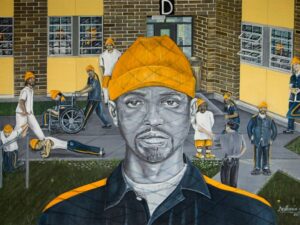Innovation drives new ideas, creativity, and belief in the potential to improve. Dr. Robert Sellers, Vice Provost for Equity and Inclusion and Chief Diversity Officer, has encouraged the University community to think big about innovation.
With the establishment of the DEI Innovation fund, supported by the Office of Diversity, Equity and Inclusion, these grants aim to support faculty, staff and student projects. The goals are to approach DEI opportunities and challenges with an innovative lens at the University of Michigan.
This opportunity supports projects that have already been implemented and are looking to expand, or those seeking to fund long-term, transformative change.
NEW PROJECT AIMS FOR CHANGES IN MEDICAL PERSONEL REPRESENTATION
A newer initiative, the Mentorship-led Pipeline Program Between the U-M Medical School and Kellogg Eye Center, is driven to address minority representation in ophthalmology, and to develop a more diverse pool of applicants for residency programs.
“The number one thing is providing good mentorship for underrepresented minorities,” says Dr. Shahzad Mian, Ophthalmologist and Principle Investigator of the project. “[Mentees] can ask questions, gain exposure, and learn to be good students and be good stewards.”
Through the mentorship program, the goal of increasing the level of diversity among ophthalmologists aims to represent better the patient populations they serve and help reduce inequalities in vision care.
“Our goal is to have some of [the students], if not most of them, pursue careers in ophthalmology so we can increase the number of optimists who come from underrepresented minority backgrounds, therefore addressing the issue of patient care.”
The program includes core areas of support, such as recruitment, mentorship, surgical simulation, and networking, all of which are made possible with the assistance of the DEI Innovation Grant fund.
“It’s impacted [the program] immensely,” says Mian. “We wouldn’t be able to get things started – it takes funds to be able to organize actives for the students and residents and to give them the appropriate mentorship they need. Our hope is that this will generate better discussion on healthcare disparities [and] support for students to pursue careers in ophthalmology – to help build the field, and be truly representative of our patient population.”
LONG-STANDING PROJECTS BENEFIT, ADAPT WITH ADDITIONAL SUPPORT

The Gender Consciousness Project (GCP): Girls Learn Resistance to Gender Injustice Starting in High School, is a faculty-led initiative that aims to cultivate long-lasting, cultural change.
Established in 2000, GCP is a grassroots program that develops awareness surrounding the complexities of gender discrimination. The program recently completed its second year impacting high school-aged young women in Ypsilanti, Belleville and Ann Arbor.
“What we do is try to get the girls [to] not really look at the injustices, but how they participate in the injustices themselves,” says Nesha Haniff, Ph.D., principal investigator for GCP.
The program also addresses issues of race, religion and ethnicity, all of which Haniff says must be part of the conversation when addressing gender injustice.
GCP students attending U-M continue their involvement with the program as engaged learning interns through the Department of Afroamerican and African Studies (DAAS) in the School of Literature, Science and Arts (LSA).
As an ongoing program, continuing support is essential.
“The Innovation Grant helps pay students who work with the committee,” says Haniff.” “We got a grant of $10,000, but the work we have done in these schools and these communities is much larger than that.”
Another ongoing initiative receiving Innovation Grant funding support is the Prison Creative Arts Project (PCAP). Founded nearly three decades ago, PCAP brings those impacted by the justice system and the University of Michigan community into artistic collaboration for mutual learning and growth.
The program reaches thousands of people each year through five undergraduate courses and weekly creative arts workshops in 16 prisons and youth detention and treatment centers. Additionally, an annual literary journal, arts program for individuals released from prison, and a theatre exchange program with two universities in Brazil, make up core components of the project.
A cornerstone of the initiative, the Annual Exhibition of Art by Michigan Prisoners, now in its 24th year, is one of the most extensive exhibits of its kind in the world. It brings the work of nearly 600 artists to the Duderstadt Gallery for a two-week show.
Vanessa Mayesky, Associate Director of the Prison Creative Arts Project, has witnessed the positive impact of PCAP.

image courtesy of lsa.umich.edu
“PCAP offers an authentic way for people who might not otherwise meet, to connect with, and learn from one another,” she says. “This collaborative approach is what first drew me in as an undergrad and what has kept me involved in the years since.”
While the program has been a staple of LSA for nearly 30 years, the DEI Innovation Grant, which funded a new curatorial direction for the Annual Exhibition at a pivotal time for PCAP, was essential as two tenured faculty-curators retired.
“We needed to build a more inclusive and sustainable curatorial process,” says Mayesky. “We used the Innovation Grant to move from centering the curatorial work around two faculty members to a team approach that includes formerly incarcerated artists, students, staff and artists from the community. Our curator group has brought new perspectives to the artistic direction of the exhibit and new ideas.”
The impact of the new curation approach can be experienced March 20 – April 3 at the PCAP 24th Annual Exhibition of Art by Michigan Prisoners.
To learn more about DEI Innovation Grant opportunities, visit myumi.ch/LBY58.

